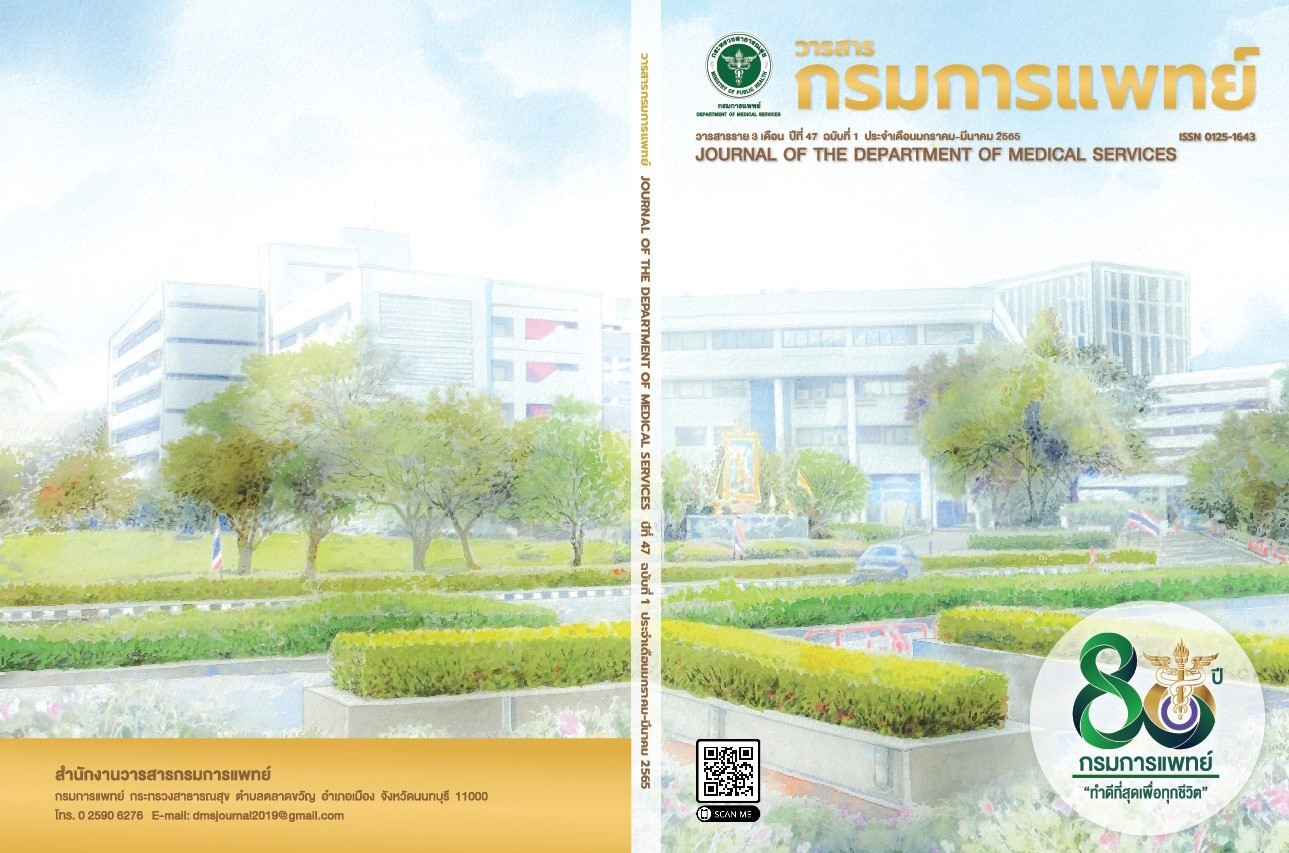Use of plasma NT-proBNP level to predict persistent pulmonary arterial hypertension in patients with secundum atrial septal defect after transcatheter closure
Keywords:
secundum ASD, ASDII, transcatheter closure, pulmonary arterial hypertension, NT-proBNPAbstract
Background: Persistent pulmonary arterial hypertension (PPAH) after transcatheter ASD closure (TCA) in patients with secundum atrial septal defect (ASDII) is associated with high morbidity and mortality. There were few reports of biomarkers as predictors of pulmonary arterial hypertension (PAH) after TCA.Objective: To determine whether plasma
NT-proBNP level can predict PPAH in ASDII patients after TCA. Method: A prospective cohort study was conducted among ASDII patients who underwent TCA in Central Chest Institute of Thailand between January 2016 and June 2016.
Demographic data, body mass index, underlying diseases and echocardiographic data were assessed. The outcome in this study was the proportion of PPAH after TCA for six months in those with normal and high NT-proBNP levels.
The outcome between two groups were compared with unpaired t-tests. Receiver operator characteristic (ROC) curve were used to illustrate the capacity of NT-proBNP prognostic predictor of PPAH in ASDII patients after TCA. Result:
A total of thirty patients were prospectively recruited. Of these, twenty patients had normal baseline NT-proBNP,and ten patients had high baseline NT-proBNP. The patients with high baseline NT-proBNP had more decreased NTproBNP than those with normal baseline NT-proBNP with statistical significance (p-value = 0.01). The proportion of patients with high baseline NT-proBNP had more PPAH than those with normal baseline NT-proBNP with statistical
significance (p-value = 0.008). The ROC curve showed that baseline NT-proBNP ≥ 240 picograms/milliliter (pg/ml)
had a sensitivity of 100%, a specificity of 88.5%, a positive predictive value of 57% and a negative predictive value of 100%). Conclusion: ASDII patients with high baseline NT-proBNP had significant PPAH after TCA compared with
those with normal baseline NT-proBNP. Baseline NT-proBNP level ≥ 240 pg/ml may be used for predicting PPAH in these patients. The further larger studies will be needed for confirmation of these findings.
References
Brest AN. Congenital heart disease in adults. Cardiovascular Clin 1970; 2:258-65.
Kangawa K, Matsuo H. Purification and complete amino acid sequence of a-human atrial natriuretic polypeptide. Biochem Biophys Res Commun 1984; 118:131-9.
Lang R, Tholken H, Ganten D, Luft FC, Ruskoaho H, Unger T. Atrial natriuretic factor: a circulating hormone stimulated by volume load- ing. Nature 1985; 314:264-6.
Sudoh T, Kangawa K, Minamino N, Matsuo H. A new natriuretic peptide in porcine brain. Nature 1988; 332:78-81.
Yasue H, Yoshimura M, Sumida H, Kikuta K, Kugiyama K, Jougasaki M, et al. Localization and mechanism of secretion of B-type natri- uretic peptide in comparison with those of A-type natriuretic peptide in normal subjects and patients with heart failure. Circulation 1994; 90:195-203.
Kisch B. Electron microscopy of the atrium of the heart: I Guinea pig. Exp Med Surg 1956; 14: 99–112.
Henry JP, Pearce JW. The possible role of cardiac stretch receptors in the induction of changes in urine flow. J Physiol 1956; 131: 572–94.
de Bold AJ, Borenstein HB, Veress AT, Sonnenberg H. A rapid and potent natriuretic response to intravenous injection of atrial myocardial extract in rats. Life Sci 1981; 28: 89–94.
Kangawa K, Fukuda A, Minamino N, Matsuo H. Purification and complete amino acid sequence of beta-rat atrial natriuretic polypeptide (beta-rANP) of 5000 daltons. Biochem Biophys Res Commun 1984; 119: 933–40.
Hosoda K, Nakao K, Mukoyama M, et al. Expression of brain natriuretic peptide gene in human heart: production in the ventricle. Hypertension 1991; 17: 1152–55.
Yasue H, Yoshimura M, Sumida H, et al. Localization and mechanism of secretion of B-type natriuretic peptide in comparison with those of A-type natriuretic peptide in normal subjects and patients with heart failure. Circulation 1994; 90: 195–203.
Sudoh T, Minamino N, Kangawa K, Matsuo H. C-type natriuretic peptide (CNP): a new member of natriuretic peptide family identified in porcine brain. Biochem Biophys Res Commun 1990; 168: 863–70.
Minamino N, Makino Y, Tateyama H, Kangawa K, Matsuo H. Characterization of immunoreactive human C-type natriuretic peptide in brain and heart. Biochem Biophys Res Commun 1991; 179: 535–42.
Edwards BS, Zimmerman RS, Schwab TR, Heublein DM, Burnett JC Jr. Atrial stretch, not pressure, is the principal determinant controlling the acute release of atrial natriuretic factor. Circ Res 1988; 62: 191–95.
Bruneau BG, Piazza LA, de Bold AJ. BNP gene expression is specifically modulated by stretch and ET-1 in a new model of isolated rat atria. Am J Physiol 1997; 273: H2678–86.
Schoen SP, Zimmermann T, Kittner T, Braun MU, Fuhrmann J, Schmeisser A et al. NT-proBNP correlates with right heart haemodynamic parameters and volumes in patients with atrial septal defects. Eur J Heart Fail. 2007;9(6-7):660-6.
Das SR, Drazner MH, Dries DL, Vega GL, Stanek HG, Abdullah SM, Canham RM, Chung AK, Leonard D, Wians FH Jr, de Lemos JA.Impact of body mass and body composition on circulating levels of natriuretic peptides: results from the Dallas Heart Study. Circulation. 2005;112(14):2163
Wang TJ, Larson MG, Levy D, Benjamin EJ, Leip EP, Wilson PW, Vasan RS.Impact of obesity on plasma natriuretic peptide levels. Circulation. 2004;109(5):594.
Zhao-Feng Liab, Da-Xin Zhoua, Qi-Bing Wanga, Wen-Zhi Pana, Lei Zhanga, Jun-Bo Gea. Plasma N-terminal pro-brain natriuretic peptide levels are positively correlated with pulmonary arterial pressure in atrial septal defect patients. Regul Pept. 2013;183:13-6.
Downloads
Published
How to Cite
Issue
Section
License
Copyright (c) 2022 Department of Medical Services, Ministry of Public Health

This work is licensed under a Creative Commons Attribution-NonCommercial-NoDerivatives 4.0 International License.
บทความที่ได้รับการตีพิมพ์เป็นลิขสิทธิ์ของกรมการแพทย์ กระทรวงสาธารณสุข
ข้อความและข้อคิดเห็นต่างๆ เป็นของผู้เขียนบทความ ไม่ใช่ความเห็นของกองบรรณาธิการหรือของวารสารกรมการแพทย์



